The Eastpointer
The Bay is Dead
By Richard E. Noble
When we first arrived in Eastpoint many were saying that the bay was dead. Even when the bay was extremely productive and there were 1000 or 1500 oyster permits sold, some people told us that things weren't like they used to be. There was a time, we were told, when the bay was so full of oyster boats that you could walk from boat to boat and never get your feet wet. Old fishermen told us that when they were kids all they needed to go fishing was a pointed stick. They would whittle the end of a stick with their pocket knife and spear spotted trout from the bank. I was told that there was a time when every oyster in the bay was the size of a grown man's hand and that there were so many shrimp in the bay that they couldn't sell all they could catch.
All the bass in the Island ponds were "clunkers" - four and five pounds each.
But whether great, good, fair or poor the bay has always been there for the local seafood workers while all other types of employment came and went.
I truly thought with this recent real-estate boom and building spree that the seafood industry was a goner – maybe gone for good. But the other week driving through Eastpoint I saw pickup trucks waiting in line with their beds full of bags of oysters. That brought back some memories. Once again, it seems when all else fails locals are pushing their old oyster boats back into the water and chugging out to the bay to scratch up a few dollars.
But I must admit if the bay isn't dead today, it is the deadest that I have ever seen it. I haven't seen any bay shrimpers out on the bay at night for years. One shrimper told me that there haven't been any shrimp in the bay for five years now. There were never a multitude of crabbers here, but there were usually enough to speckle and dot the bay with bobbers periodically. I see very few crab traps bobbing around out there in recent years. And of course even with the line of pickups at one oyster house in Eastpoint the oyster boats are sparse.
Every building along the bay in Eastpoint was once a functioning oyster house. Today there might be three or four – and some of them are selling nick-nacks or peddling trucked in seafood to the tourists. As they used to say in Eastpoint – mighty sorry, mighty sorry.
The water war with Atlanta certainly isn't helping. I hear the Governor of Atlanta was out on the steps of city hall with a group of his supporters praying for rain. Wow, now we're back to the days of Elmer Gantry.
I've read that the people in Atlanta are saving their bath water to flush their toilets. On the other hand they opened their public swimming pools when Lake Lanier was at its lowest level in history and though they are not allowed to wash their cars in their driveways, they can still go to a pay carwash – supposedly the pools and carwashes recycle their water. The Coca-Cola bottling plant that is making big bucks bottling up Dansani bottled tap water has agreed to cut back 5 or 10%.
The author that I was reading does not attribute Atlanta's problems to global warming or even to the drought. He claims that Atlanta's biggest problem is that they keep electing conservative Republicans – eight out of the last ten governors of Atlanta have been Republicans. And even the two that weren't were Dixie-crats. Those are Southern Democrats who this author claims are really red-neck Republicans and not Democrats at all.
It does seem that all groups except the governor of Atlanta and his chums are in agreement that the water problems in Atlanta are for the most part the result of poor planning or no planning at all.
But nevertheless I do see a ray of hope in all the dreariness. We still have oyster boats and shrimp boats and a fisherman here and there in Eastpoint and Franklin County. You can still catch fish in the bay – whether off the old bridge, the bank (or the hill) or the side of your boat.
I know that there are places in the US where there is water with no fish at all.
There are parts of the ocean that are completely devoid of all life – plant, fish or other, I've read. But there is still life in Apalachicola Bay.
I doubt that Apalachicola bay will ever return to a time when you could walk from oyster boat to oyster boat without getting your feet wet or the days when you could catch spotted trout with a pointed stick or when the oysters were all as big as a man's hand or the ponds on the islands were filled with four and five pound bass – but we're still alive, maybe just barely alive but still alive.
Richard E. Noble has published 16 books. They are all for sale on Amazon.com. Richard Noble is a freelance writer and has been a resident of Eastpoint for 30 years. If you would like to stock his books in your store or business he can be contacted at richardedwardnoble@gtcom.net.
Subscribe to:
Post Comments (Atom)







































No comments:
Post a Comment